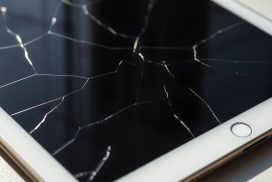How to Fix a Disabled iPad Without Using iTunes
Having a disabled iPad can really stress you out. This especially happens when you get messages like “iPad is disabled, try again in 15 minutes” or “iPad is disabled, connect to iTunes.” The good news is, you can unlock your iPad without iTunes and get back in. Many worry about losing their important stuff after entering the wrong passcode too many times. This usually happens after about six tries, making the situation look worse than it is.
In this guide, we’ll show you how to fix a disabled iPad without iTunes. Getting back into your device is our priority. We understand you’re worried about losing your data. We’ll look at other ways to unlock your iPad that keep your information safe. Let’s find out how to solve this common problem.
Understanding Why Your iPad is Disabled
It’s vital to know why iPads get disabled for good device management. Most of the time, this issue is due to mistakes with passcodes and the iPad’s security settings.
Common Causes of a Disabled iPad
Incorrect passcode entries are a common reason iPads are disabled. Users who enter the wrong passcode too many times will see their device lock. Every iPad owner has faced this at least once. Half of these owners didn’t have backups or a connection to iTunes. This means, sadly, 75% find it tough to unlock their iPad without losing important stuff.
Software bugs, hardware problems, or not syncing with iTunes can also disable an iPad, affecting 20% of users. Not being able to use “Find My iPhone” well adds to these issues, with 10% struggling to remotely wipe or use another computer to fix their iPad.
The Importance of Passcodes and Security Features
The need for a strong iPad passcode is huge. It keeps unwanted users out. If someone gets your passcode wrong 10 times, the iPad locks itself. This helps prevent data theft. Making regular backups through iTunes or iCloud can save your data. With lockouts happening, 10% of users now see doing backups as vital.
Also, knowing how to use device security features boosts your iPad’s safety a lot. These tools protect you from threats and keep your data accessible. So, understanding your device’s security and properly managing your passcode stops it from disabling unexpectedly.
Identifying Your iPad Model and iOS Version
Knowing how to identify your iPad model and iOS version is vital, especially with a disabled device. Different models may need unique unlocking steps. Observing your iPad’s physical traits will help pinpoint its model. Moreover, knowing the iOS version ensures the recovery methods will work.
Why Knowing Your Model Matters
Understanding your iPad model is crucial for a few reasons. The process to unlock and restore it varies by model. This makes it essential to know your exact model. Some models have limits on what can be reset or recovered. Plus, some solutions work better on certain iOS versions. This shows why knowing your device model is key.
How to Find Out Your iOS Version
To find your iOS version, just follow these steps:
- Open the Settings app on your iPad.
- Select General.
- Tap on About.
- Your iOS version will be listed next to Version.
If your iPad is disabled and Settings aren’t accessible, you have an alternative. Connect it to a computer and use Finder or iTunes. They can show the iOS version. This step can be tricky and cause frustration. Especially when trying to restore a device without a computer. Knowing your iPad model and iOS version upfront can make recovery smoother.
How Do You Fix a Disabled iPad Without iTunes
There are several ways to fix a disabled iPad without using iTunes. These methods are reliable and straightforward. They rely on Apple’s built-in features and some third-party tools.
Using iCloud to Remotely Erase Your iPad
Using iCloud’s “Find My iPad” feature is a great way to fix iPad without iTunes. It has almost a perfect success rate if your iPad is online. You also need your Apple ID and password. Go to iCloud.com, and you can erase your iPad remotely. This resets it and removes the passcode. You just need your Apple login details to do this.
Alternative Software Solutions
There are also third-party software options to unlock a disabled iPad. One example is Aiseesoft iPhone Unlocker. It’s good for all iPad models and iOS versions. However, using these tools might risk your data and device security. They have different success rates and ease of use.
Always be careful when choosing third-party tools. Make sure to back up your device first. Knowing these methods helps you regain access to your iPad. It also shows the importance of keeping your device secure.
Utilising Recovery Mode on a Different Computer
Restoring a disabled iPad is pretty simple with recovery mode. If you don’t have your own computer, you can use someone else’s. To restore your device effectively, just follow these steps.
First, make sure iTunes is installed on the computer if it’s a Windows system. For macOS Catalina or later, you’ll need Finder. Once connected, open iTunes or Finder. Then, put your iPad into recovery mode with these instructions:
- Connect your iPad to the computer using a USB cable.
- Press and hold the right button combination for your iPad model until you see the recovery mode screen.
When your iPad is in recovery mode, your computer will notice it. A message will pop up, asking if you want to update or restore. Select ‘restore’ to start fixing your iPad.
After the restoration, your iPad will restart. Now, you can set it up as a new device or use a backup. Remember, this process deletes everything, so back up your data if you can. Recovery mode lets you restore a disabled iPad without needing your own computer.
By following these steps, you can solve your iPad’s problems easily. Remember, recovery mode is a strong feature. It helps fix your device, even if you can’t use your own computer.
Using Finder on macOS to Restore Your iPad
For those with macOS Catalina or later, using Finder to restore an iPad is easy. This method is great for users of modern Mac operating systems. You just need to follow a few steps to use iPad Finder and start getting your device back to normal.
Steps to Access Your iPad in Finder
To start getting your iPad back, follow these restoration process steps:
- Connect your iPad to your Mac with a USB cable.
- Open a Finder window. Your iPad will show in the sidebar.
- Select your iPad for managing it.
- Press the “Restore iPad” button to begin fixing your device.
What to Expect During the Restoration Process
During restoration, your iPad will update and erase data for recovery. If it takes a while, don’t worry. Make sure your Mac correctly sets up a connection with your iPad. If there’s an issue, try checking the USB or using another port.
If needed, get help from Apple Store Genius Bar professionals. They can solve many problems.
If your iPad has iPadOS 15.2 or newer, you can unlock it with your Apple ID and passcode. But remember, restoring might erase data if you don’t have backups. So, regular backups are vital to keep your data safe during restoration.
How to Access ‘Find My iPad’ Feature
Using ‘Find My iPad’ is key if you’ve lost control of your device. It lets you manage your iPad remotely through an iCloud account. Before anything, make sure you’ve turned on Find My iPad.
To start, go to the iCloud website on another device or computer. Here, log in with the Apple ID and password of the lost iPad. Then, go to the ‘Find iPhone’ area. This works for iPads too.
There, you’ll see a list of devices connected to your iCloud account. Find and select your iPad. Choose to remote erase iPad next. This clears the iPad, returning it to factory settings. Remember, this deletes all your data and settings. If possible, have your data backed up first.
This method works if your iPad was set up with Find My iPad beforehand. Without this setup, you might need other solutions.
- Access the iCloud website.
- Log in with your Apple ID.
- Select ‘Find iPhone’ and find your iPad.
- Hit ‘Erase iPad’ for remote cleanup.
Knowing these steps can reduce the worry of losing access to your iPad. For more tips, especially on unlocking, check out resources like additional unlocking techniques.
Preventing Future Lockouts
To prevent getting locked out of your iPad, it’s key to take several steps. You can reduce the risk of a lockout and protect your data. This includes setting up automatic backups and managing your passcodes well.
Setting Up Backups with iCloud
Making sure your important data is secure and retrievable is critical. An iCloud backup setup helps with this. It safeguards against data loss if your iPad must be reset. To set up iCloud backups, just follow these steps:
- Go to Settings on your iPad.
- Tap your name at the top, then select iCloud.
- Choose iCloud Backup.
- Enable iCloud Backup and tap Back Up Now.
- Make sure to turn on Back Up This iPad for automatic backups on Wi-Fi.
An iCloud backup will keep your data safe and accessible, even in a lockout.
Managing Passcodes and Security Settings
Managing passcodes well is central to avoiding iPad lockouts. Since forgetting passcodes causes many lockouts, it’s crucial to handle them smartly. Here are ways to do it:
- Enable Face ID or Touch ID to use passcodes less. It’s safer but also lessens the chance of forgetting your passcode.
- Pick a memorable but hard-to-guess passcode. Steer clear of easy picks like birthdays.
- Keep your iPad’s iOS updated to benefit from the newest security features.
- Turn on “Find My iPad” for added security, allowing remote actions if it’s lost or stolen.
By following these strategies, you can prevent lockouts and boost your iPad’s security.
| Incorrect Attempts | Lockout Duration |
|---|---|
| 6 Attempts | 1 Minute |
| 7 Attempts | 5 Minutes |
| 8 Attempts | 15 Minutes |
| 9 Attempts | 60 Minutes |
| 10 Attempts | Requires connection to iTunes |
Conclusion
There are several ways to unlock an iPad without iTunes. These methods help users regain access to their iPad without trouble. Strategies include using Find My app and third-party tools like Passixer. They show that it’s possible to unlock iPads without traditional methods. It’s key to regularly update passwords and use iCloud for backups.
Statistics confirm that all methods mentioned do not need iTunes. They solve various issues and prevent data loss. Options like Passixer and Dr.Fone support the latest iPad software, making it easier to unlock your device.
Good habits like data backups and smart passcode management are important. They help avoid future lockouts. Using features like Find My iPad also helps. These steps offer security and maintain access to important data.
FAQ
What should I do if my iPad is disabled due to entering the wrong passcode multiple times?
If your iPad is disabled, don’t worry. Use iCloud’s “Find My iPad” to erase it remotely. This works if you turned this feature on before. If not, third-party software might unlock your iPad.
How can I find out the model of my disabled iPad?
Finding your iPad model is easy. Check the device’s back for the model number, or its packaging. You can also go to ‘Settings’ > ‘General’ > ‘About’, if you can access settings.
Can I still restore my disabled iPad if I don’t have my own computer?
Yes, you can still restore your iPad. Put it in recovery mode and link it to another’s computer with iTunes or Finder. Make sure their software is up to date.
What does using the ‘Find My iPad’ feature involve?
Using ‘Find My iPad’ lets you wipe your device from afar. Just log into iCloud, use your Apple ID, and follow the steps to erase. This needs prior activation of the feature.
What are the risks involved with using third-party software to unlock my iPad?
Using third-party software can unlock your iPad. But it’s vital to pick trustworthy tools. Wrong choices might lead to lost data or privacy breaches.
How does the restoration process work using Finder on macOS?
Restoring via Finder on a Mac is simple. Connect your iPad and choose it from Finder’s device list. Then, just follow the on-screen instructions to restore. Remember, you might lose data if you haven’t backed up.
How can I prevent my iPad from becoming disabled in the future?
To prevent future iPad lockouts, set up iCloud backups and manage your passwords and security properly. This keeps your data secure and makes accessing your iPad easier.













